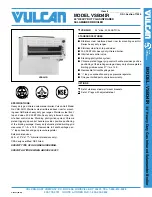
74
NOTE
When the combustion air fan is removed for any reason, the inlet to the burner must be covered to prevent further foreign objects
from falling into the burner. Always look inside the burner to check for dents. Do not place a burner back into operation if the inner
distribution screen has been dented during the service operation, call the factory for recommendations. Use care when removing
and handling the burner, Sharp objects or impact may damage or tear the metal fiber surface rendering the burner unfit for service.
10.5.2
BURNER CLEANING PROCEDURE
Remove any visible dust or dirt blockage from the surface of the burner using water from a garden house. Wash the burner with low
pressure water. Never wipe or brush the surface of the burner nor use high pressure water or air.
The burner may best be cleaned by immersing the burner port area in a solution of dishwashing detergent and hot water. Allow the
burner to remain in the solution for a short period of time to remove dust, dirt and oil or grease laden contaminants. Rinse the burner
thoroughly with clean water to remove any residue from the detergent cleaner. The burner should be air dried after removal from the
cleaning solution and rinsing.
DO NOT
use chlorine based solvents or cleaning agents on the burner.
10.6
CHANGING THE HOT SURFACE IGNITER
The
Hot Surface Igniter
is to be checked at least after every 4000 hours of operation and more frequently under high cycling
conditions. This will maintain peak ignition efficiency.
Turn off main electrical power to the appliance.
Turn off main manual gas shutoff to the appliance.
Locate the
Hot Surface Igniter
.
Disconnect the two power leads to the
Hot Surface Igniter
.
Loosen and remove the two screws that hold the igniter.
Lift the igniter vertically out of the burner mounting flange. Use care, do not hit or break the silicon carbide igniter.
DO NOT
pull out
by leads.
10.6.1
RE-INSTALLING THE IGNITER
Confirm that the end of the replacement igniter has a bead of silicone sealing the gap between the metal mounting flange and the
ceramic shaft of the igniter.
Ensure that the ceramic paper gaskets used to seal the base and top of the igniter are reinstalled on the new igniter.
Carefully insert the ignite
r into the mounting point on the burner flange and push into position on top of the fan’s flange
Reinstall the two mounting head screws and tighten by hand only.
Ensure that the igniter ceramic paper gaskets are properly installed and seal the point of contact between the igniter and fan mounting
flange.
Reconnect the power leads to the igniter.
Turn on main gas supply.
Turn on main power.
Test fire the appliance to ensure proper operation.
The igniter must generate minimum 3A to reliably light the main burner (AV500
– 2500) or pilot (AV3000 – 4000).
10.7
HEAT EXCHANGER INSPECTION
The heat exchanger should be inspected at the time of burner maintenance.
Turn off all power to the appliance.
Turn off main gas to the appliance.
Remove top cover.
Remove fan assembly and burner as detailed in the Burner and Cleaning section.
Check the heat exchanger tubes and combustion chamber. If soot is present, heat exchanger must be cleaned
Remove the front outer jacket door.
Use detergent water pressure wash to remove soot from heat exchanger tubes and combustion chamber.
Disconnect condensate/ neutralizer box and allow dirty wash water to drain away
Reinstall the burner and fan assembly.
Reassemble all gas piping. Test for gas leaks.
Reassemble outer jacket panels. Keep top cover off.
Cycle unit and check for proper operation.
Once proper operation is confirmed replace the top cover.
Summary of Contents for ADVANTUS AVH 1000
Page 2: ......
Page 3: ......
Page 38: ...31 Figure 23 Recommended Piping with Reverse Return and Variable Primary Flow...
Page 88: ...81 PART 12 EXPLODED VIEW Figure A...
Page 89: ...82 Figure B FAN BURNER ASSEMBLY AV500 600 some items may not be as shown...
Page 90: ...83 Figure C FAN BURNER ASSEMBLY AV800 4000 some items may not be as shown...
Page 91: ...84 Figure D Figure E...
Page 92: ...85 Figure F Figure G...
Page 93: ...86 Figure H CONTROL BOARD ASSEMBLY...
Page 100: ...93 PART 13 ELECTRICAL DIAGRAMS...
Page 101: ...94...
Page 102: ...95...
















































